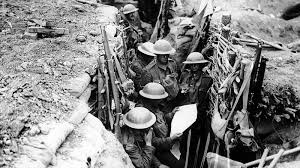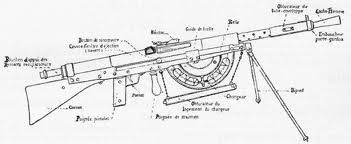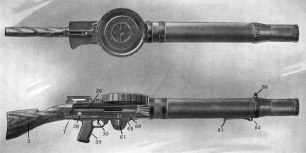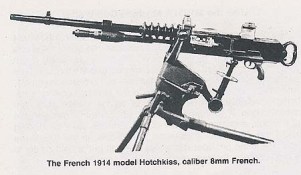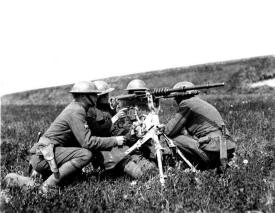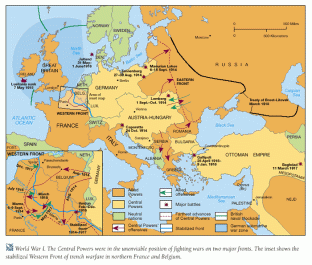Tracey Nguyen
Shequasha Barnett-Cooper
How Did World War I Change Warfare? World War I was also known as the Great War or the First World War and the War to End All Wars. This conflict lasted from 1914 to 1919. World War I was fought by Central powers on one side and Allies on the other. This war was recorded as one of the bloodiest conflicts in history. World War I was notorious for its trench war fares and machine guns. The trench line cutting across Europe made a significant impression not only on how the war was fought but also how it is remembered. Until the machine guns were invented using a rifle was slow, considering that only one bullet could be shot at a time then once shots have been fired, the rifle needed to be reloaded using the bolt. The machine guns were designed to shoot continuously–hundreds of bullets per minute. The introduction of the machine gun forced a change in traditional battlefield tactics.
Machine guns were one of the primary reasons why World War I was the deadliest war
and led to trench warfare. Planes and tanks were in their infancy and there were very few Calvary so it was just infantry and artillery that led the war. “At first, only the Germans appreciated the power of machine-guns when used on the defense from prepared positions with overlapping fields of fire. All armies would soon learn this lesson, as the machine-gun, perhaps more than any other weapon, drove soldiers from the battlefield and into relatively safe trenches, dug-outs, and fortifications. Overcoming the stalemate created by the dominance of firepower would challenge armies for the rest of the war.” With the advancement of machine guns, Calvary wasn’t needed in World War I as much as it was needed in the Civil War. Contribution to the successes of the development of machine guns had to do with the way soldiers were trained to attack. The infantry would all charge forward in waves. This was an effective means when the enemy was only equipped with rifles where one had to aim and shoot in order to hit another. However, when a wave of charging men are equipped with machine guns, they are able to wipe out the enemies easily because with a machine gun taking a careful aim is not needed. It bogged warfare down, taking away tactical and strategic mobility and turned it into a destructive slugfest.
“Machine-gun fire is far more deadly than rifle fire. The gun’s mount gives its fire precision and absorbs its recoil.” A couple machine guns that were used in World War I are called the Vickers machine gun, Hotchkiss, and the Lewis gun. The Vickers gun was created originally for the British Army by Vickers Limited. This specific machine gun is categorized as a medium machine gun, it required a six-to-eight team to operate; one fired, one fed the ammunition, and the rest helped carry the weapon. The Hotchkiss machine gun (used for Calvary and tank use), also known as the Hotchkiss M1909 or M1909 Benét–Mercié originated from France as a light machine gun and was developed by Hotchkiss et Cie in 1901. Another machine-gun the British used in World War I is the Lewis gun. “The Lewis gun was invented in 1911 by Isaac Newton Lewis who at the time was a Colonel in the U.S. army.” Consequently machine guns would often be grouped together to maintain a constant defensive position.
Development and mass deployment of military technology played a critical role in the First World War. Between World War I and World War II, World War II definitely advanced in artilleries. The biggest weapon advancement that changed the way war was fought were machine guns. This invention caused troops to give up full frontal attacks in order to keep the trenches safe. Modern weapons such as the bolt action rifles, belt fed guns, and rapid firing breech loaded artillery – could convey vastly more firepower much faster and more accurate than any previous weapon system. ” The machine gun had a large impact on the war because now masses of soldiers would be instantly demolished because of the machine gun’s amazing ability to fire projectiles at fast rates.” In World War II, technology continued to advance. Machine guns and rifles were used on both sides of the war. Anti-tank weapons were used and hand grenades became an essential part of gear that a soldier had in the infantry. Overall, World War I changed warfare with the new advancements and inventions of technology.
http://www.bbc.co.uk/learningzone/clips/killing-for-your-country-during-world-war-one/12743.html
Sources:
“Weapons on Land – Machine-Guns | Canada and the First World War.” Canada and the First World War MachineGuns Comments. Web. 23 Oct. 2014.
“Machine Guns.” Machine Guns. Web. 23 Oct. 2014.
“Machine Gun on the Western Front.” Military History Monthly. Web. 23 Oct. 2014.
“THE LEWIS GUN.” THE LEWIS GUN. Web. 23 Oct. 2014.
“Modern Firearms.” – Lewis. Web. 23 Oct. 2014.
“Difference Between WWI and WWII | Difference Between | WWI vs WWII.” Difference Between WWI and WWII | Difference Between | WWI vs WWII. Web. 23 Oct. 2014.
